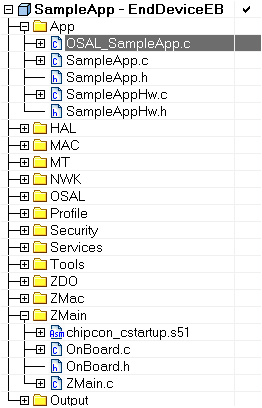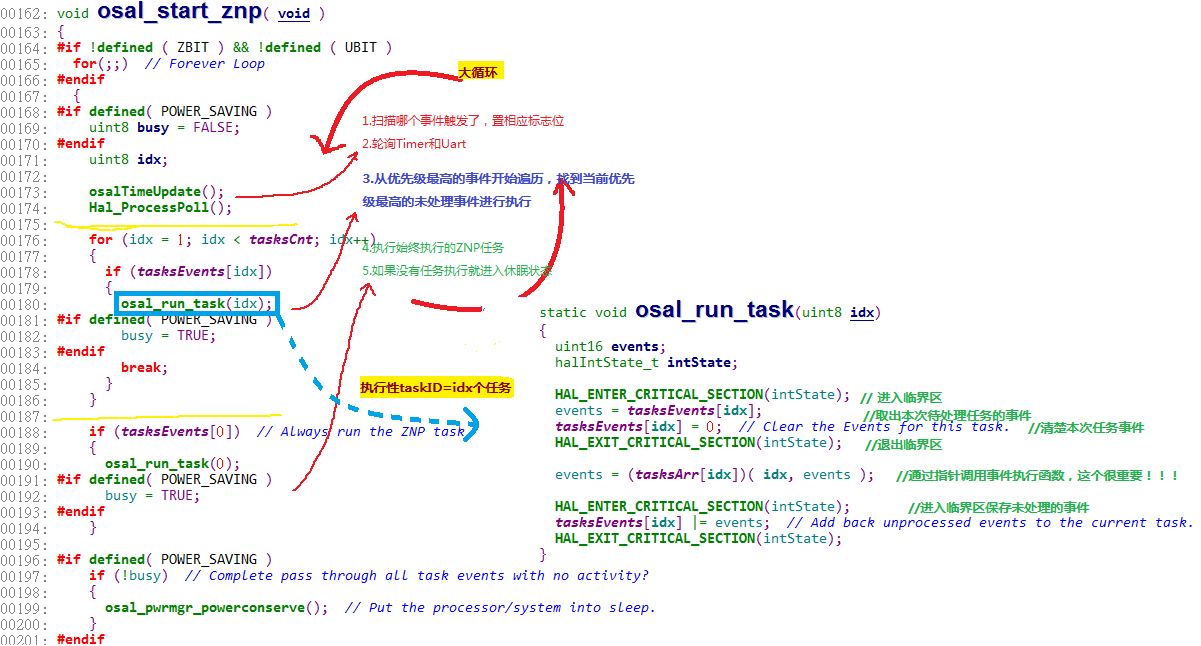说在前面:上一篇介绍了无线LED闪烁实现的OSAL部分,本篇介绍如何实现无线数据收发及数据处理:
上一篇是用SI跟着流程查看源码,我个人认为以架构的思维去了解代码能让人更清晰

::ZMain.c程序入口文件
这里chipcon_cstartup.s51是汇编的启动文件,ZMain.c相当于main文件,里面有main函数:
1 int main( void ) 2 { 3 osal_int_disable( INTS_ALL );// Turn off interrupts 关中断 4 HAL_BOARD_INIT();// Initialization for board related stuff such as LEDs 5 zmain_vdd_check();// Make sure supply voltage is high enough to run 检查芯片是否上电正常 6 InitBoard( OB_COLD );// Initialize board I/O 初始化I/O,LED,Timer等 7 HalDriverInit();// Initialze HAL drivers 初始化硬件抽象层驱动模块 8 osal_nv_init( NULL );// Initialize NV System 初始化flash存储器 9 znpTestRF();// Initialize and check the ZNP RF Test Mode NV items. 10 ZMacInit();// Initialize the MAC 初始化MAC层 11 zmain_ext_addr();// Determine the extended address 确定IEEE64位地址 12 13 #if defined ZCL_KEY_ESTABLISH 14 zmain_cert_init();// Initialize the Certicom certificate information. 15 #endif 16 17 zgInit();// Initialize basic NV items 初始化非易失变量 18 19 #ifndef NONWK 20 afInit();// Since the AF isn't a task, call it's initialization routine 21 #endif 22 23 osal_init_system();// Initialize the operating system 初始化OS(重点介绍1) 24 osal_int_enable( INTS_ALL );// Allow interrupts 使能中断 25 InitBoard( OB_READY );// Final board initialization 最终板载初始化 26 zmain_dev_info();// Display information about this device 显示设备信息(这里有LCD屏幕) 27 28 #ifdef LCD_SUPPORTED/* Display the device info on the LCD 将信息显示在LCD上*/ 29 zmain_lcd_init(); 30 #endif 31 32 #ifdef WDT_IN_PM1 33 WatchDogEnable( WDTIMX );/* If WDT is used, this is a good place to enable it. */ 34 #endif 35 36 osal_start_znp(); // No Return from here 执行操作系统(重点介绍2) 37 38 return 0; // Shouldn't get here. 39 } // main()
main主要是初始化,然后启动OS,进入大循环,根据任务优先级处理相应任务。
::OSAL_SampleApp.c任务数组及任务初始化文件
上篇讲到main函数核心有:


初始化最核心的是OSAL任务初始化:(这里的tasksArr是所有任务的索引,后文还会介绍)
1 /********************************************************************* 2 * GLOBAL VARIABLES 3 */ 4 5 // The order in this table must be identical to the task initialization calls below in osalInitTask. 6 const pTaskEventHandlerFn tasksArr[] = 7 { 8 macEventLoop, 9 nwk_event_loop, 10 Hal_ProcessEvent, 11 #if defined( MT_TASK ) 12 MT_ProcessEvent, 13 #endif 14 APS_event_loop, 15 #if defined ( ZIGBEE_FRAGMENTATION ) 16 APSF_ProcessEvent, 17 #endif 18 ZDApp_event_loop, 19 #if defined ( ZIGBEE_FREQ_AGILITY ) || defined ( ZIGBEE_PANID_CONFLICT ) 20 ZDNwkMgr_event_loop, 21 #endif 22 SampleApp_ProcessEvent 23 }; 24 25 const uint8 tasksCnt = sizeof( tasksArr ) / sizeof( tasksArr[0] ); 26 uint16 *tasksEvents; 27 28 /********************************************************************* 29 * FUNCTIONS 30 *********************************************************************/ 31 32 /********************************************************************* 33 * @fn osalInitTasks 34 * 35 * @brief This function invokes the initialization function for each task. 36 * 37 * @param void 38 * 39 * @return none 40 */ 41 void osalInitTasks( void ) 42 { 43 uint8 taskID = 0; 44 45 // 分配内存,返回指向缓冲区的指针 46 tasksEvents = (uint16 *)osal_mem_alloc( sizeof( uint16 ) * tasksCnt); 47 // 设置所分配的内存空间单元值为0 48 osal_memset( tasksEvents, 0, (sizeof( uint16 ) * tasksCnt)); 49 50 // 任务优先级由高向低依次排列,高优先级对应taskID 的值反而小 51 macTaskInit( taskID++ ); //macTaskInit(0) ,用户不需考虑 52 nwk_init( taskID++ ); //nwk_init(1),用户不需考虑 53 Hal_Init( taskID++ ); //Hal_Init(2) ,用户需考虑 54 #if defined( MT_TASK ) 55 MT_TaskInit( taskID++ ); 56 #endif 57 APS_Init( taskID++ ); //APS_Init(3) ,用户不需考虑 58 #if defined ( ZIGBEE_FRAGMENTATION ) 59 APSF_Init( taskID++ ); 60 #endif 61 ZDApp_Init( taskID++ ); //ZDApp_Init(4) ,用户需考虑 62 #if defined ( ZIGBEE_FREQ_AGILITY ) || defined ( ZIGBEE_PANID_CONFLICT ) 63 ZDNwkMgr_Init( taskID++ ); 64 #endif 65 //用户创建的任务 66 SampleApp_Init( taskID ); // SampleApp_Init _Init(5) ,用户需考虑 67 }
::SampApp.c文件APP任务实现文件
承接上面66行,SampleApp_Init( uint8 task_id )负责初始化本工程定制化任务无线LED闪烁相关的初始化工作:

1 void SampleApp_Init( uint8 task_id ) 2 { 3 SampleApp_TaskID = task_id; //osal分配的任务ID随着用户添加任务的增多而改变 4 SampleApp_NwkState = DEV_INIT;//设备状态设定为ZDO层中定义的初始化状态 5 SampleApp_TransID = 0; //消息发送ID(多消息时有顺序之分) 6 7 // Device hardware initialization can be added here or in main() (Zmain.c). 8 // If the hardware is application specific - add it here. 9 // If the hardware is other parts of the device add it in main(). 10 11 #if defined ( BUILD_ALL_DEVICES ) 12 // The "Demo" target is setup to have BUILD_ALL_DEVICES and HOLD_AUTO_START 13 // We are looking at a jumper (defined in SampleAppHw.c) to be jumpered 14 // together - if they are - we will start up a coordinator. Otherwise, 15 // the device will start as a router. 16 if ( readCoordinatorJumper() ) 17 zgDeviceLogicalType = ZG_DEVICETYPE_COORDINATOR; 18 else 19 zgDeviceLogicalType = ZG_DEVICETYPE_ROUTER; 20 #endif // BUILD_ALL_DEVICES 21 22 //该段的意思是,如果设置了HOLD_AUTO_START宏定义,将会在启动芯片的时候会暂停启动 23 //流程,只有外部触发以后才会启动芯片。其实就是需要一个按钮触发它的启动流程。 24 #if defined ( HOLD_AUTO_START ) 25 // HOLD_AUTO_START is a compile option that will surpress ZDApp 26 // from starting the device and wait for the application to 27 // start the device. 28 ZDOInitDevice(0); 29 #endif 30 31 // Setup for the periodic message's destination address 设置发送数据的方式和目的地址寻址模式 32 // Broadcast to everyone 发送模式:广播发送 33 SampleApp_Periodic_DstAddr.addrMode = (afAddrMode_t)AddrBroadcast;//广播 34 SampleApp_Periodic_DstAddr.endPoint = SAMPLEAPP_ENDPOINT; //指定端点号 35 SampleApp_Periodic_DstAddr.addr.shortAddr = 0xFFFF;//指定目的网络地址为广播地址 36 37 // Setup for the flash command's destination address - Group 1 组播发送 38 SampleApp_Flash_DstAddr.addrMode = (afAddrMode_t)afAddrGroup; //组寻址 39 SampleApp_Flash_DstAddr.endPoint = SAMPLEAPP_ENDPOINT; //指定端点号 40 SampleApp_Flash_DstAddr.addr.shortAddr = SAMPLEAPP_FLASH_GROUP;//组号0x0001 41 42 // Fill out the endpoint description. 定义本设备用来通信的APS层端点描述符 43 SampleApp_epDesc.endPoint = SAMPLEAPP_ENDPOINT; //指定端点号 44 SampleApp_epDesc.task_id = &SampleApp_TaskID; //SampleApp 描述符的任务ID 45 SampleApp_epDesc.simpleDesc 46 = (SimpleDescriptionFormat_t *)&SampleApp_SimpleDesc;//SampleApp简单描述符 47 SampleApp_epDesc.latencyReq = noLatencyReqs; //延时策略 48 49 // Register the endpoint description with the AF 50 afRegister( &SampleApp_epDesc ); //向AF层登记描述符 51 52 // Register for all key events - This app will handle all key events 53 RegisterForKeys( SampleApp_TaskID ); // 登记所有的按键事件 54 55 // By default, all devices start out in Group 1 56 SampleApp_Group.ID = 0x0001;//组号 57 osal_memcpy( SampleApp_Group.name, "Group 1", 7 );//设定组名 58 aps_AddGroup( SAMPLEAPP_ENDPOINT, &SampleApp_Group );//把该组登记添加到APS中 59 60 #if defined ( LCD_SUPPORTED ) 61 HalLcdWriteString( "SampleApp", HAL_LCD_LINE_1 ); //如果支持LCD,显示提示信息 62 #endif 63 }
上篇讲过OS启动后进入大循环,扫描当前优先级最高的任务执行!

其中若osal_run_task执行了本工程定制化任务的消息,通过调用tasksArr[idx](上面 OSAL_SampleApp.c中讲的任务数组)就相当于调用了SampleApp_ProcessEvent函数,将消息传送给任务处理函数:
1 //用户应用任务的事件处理函数 2 uint16 SampleApp_ProcessEvent( uint8 task_id, uint16 events ) 3 { 4 afIncomingMSGPacket_t *MSGpkt; 5 (void)task_id; // Intentionally unreferenced parameter 6 7 if ( events & SYS_EVENT_MSG ) //接收系统消息再进行判断 8 { 9 //接收属于本应用任务SampleApp的消息,以SampleApp_TaskID标记 10 MSGpkt = (afIncomingMSGPacket_t *)osal_msg_receive( SampleApp_TaskID ); 11 while ( MSGpkt ) 12 { 13 switch ( MSGpkt->hdr.event ) 14 { 15 // Received when a key is pressed 16 case KEY_CHANGE://按键事件 17 SampleApp_HandleKeys( ((keyChange_t *)MSGpkt)->state, ((keyChange_t *)MSGpkt)->keys ); 18 break; 19 20 // Received when a messages is received (OTA) for this endpoint 21 case AF_INCOMING_MSG_CMD://接收数据事件,调用函数AF_DataRequest()接收数据 22 SampleApp_MessageMSGCB( MSGpkt );//调用回调函数对收到的数据进行处理(1、数据发送函数) 23 break; 24 25 // Received whenever the device changes state in the network 26 case ZDO_STATE_CHANGE: 27 //只要网络状态发生改变,就通过ZDO_STATE_CHANGE事件通知所有的任务。 28 //同时完成对协调器,路由器,终端的设置 29 SampleApp_NwkState = (devStates_t)(MSGpkt->hdr.status); 30 //if ( (SampleApp_NwkState == DEV_ZB_COORD)//实验中协调器只接收数据所以取消发送事件 31 if ( (SampleApp_NwkState == DEV_ROUTER) || (SampleApp_NwkState == DEV_END_DEVICE) ) 32 { 33 // Start sending the periodic message in a regular interval. 34 //这个定时器只是为发送周期信息开启的,设备启动初始化后从这里开始 35 //触发第一个周期信息的发送,然后周而复始下去 36 osal_start_timerEx( SampleApp_TaskID, 37 SAMPLEAPP_SEND_PERIODIC_MSG_EVT, 38 SAMPLEAPP_SEND_PERIODIC_MSG_TIMEOUT ); 39 } 40 else 41 { 42 // Device is no longer in the network 43 } 44 break; 45 46 default: 47 break; 48 } 49 50 // Release the memory 事件处理完了,释放消息占用的内存 51 osal_msg_deallocate( (uint8 *)MSGpkt ); 52 53 // Next - if one is available 指针指向下一个放在缓冲区的待处理的事件, 54 //返回while ( MSGpkt )重新处理事件,直到缓冲区没有等待处理事件为止 55 MSGpkt = (afIncomingMSGPacket_t *)osal_msg_receive( SampleApp_TaskID ); 56 } 57 58 // return unprocessed events 返回未处理的事件 59 return (events ^ SYS_EVENT_MSG); 60 } 61 62 // Send a message out - This event is generated by a timer 63 // (setup in SampleApp_Init()). 64 if ( events & SAMPLEAPP_SEND_PERIODIC_MSG_EVT ) 65 { 66 // Send the periodic message 处理周期性事件, 67 //利用SampleApp_SendPeriodicMessage()处理完当前的周期性事件,然后启动定时器 68 //开启下一个周期性事情,这样一种循环下去,也即是上面说的周期性事件了, 69 //可以做为传感器定时采集、上传任务 70 SampleApp_SendPeriodicMessage(); 71 72 // Setup to send message again in normal period (+ a little jitter) 73 osal_start_timerEx( SampleApp_TaskID, SAMPLEAPP_SEND_PERIODIC_MSG_EVT, 74 (SAMPLEAPP_SEND_PERIODIC_MSG_TIMEOUT + (osal_rand() & 0x00FF)) ); 75 76 // return unprocessed events 返回未处理的事件 77 return (events ^ SAMPLEAPP_SEND_PERIODIC_MSG_EVT); 78 } 79 80 // Discard unknown events 81 return 0; 82 }
接收函数:
1 //接收数据,参数为接收到的数据 2 void SampleApp_MessageMSGCB( afIncomingMSGPacket_t *pkt ) 3 { 4 uint16 flashTime; 5 byte buf[3]; 6 7 switch ( pkt->clusterId ) //判断簇ID 8 { 9 case SAMPLEAPP_PERIODIC_CLUSTERID: //收到广播数据 10 osal_memset(buf, 0 , 3); 11 osal_memcpy(buf, pkt->cmd.Data, 2); //复制数据到缓冲区中 12 13 if(buf[0] == 'D' && buf[1] == '1') //判断收到的数据是否为"D1" 14 { 15 HalLedBlink(HAL_LED_1, 0, 50, 500);//如果是则Led1间隔500ms闪烁 16 #if defined(ZDO_COORDINATOR) //协调器收到"D1"后,返回"D1"给终端,让终端Led1也闪烁 17 SampleApp_SendPeriodicMessage(); 18 #endif 19 } 20 else 21 { 22 HalLedSet(HAL_LED_1, HAL_LED_MODE_ON); 23 } 24 break; 25 26 case SAMPLEAPP_FLASH_CLUSTERID: //收到组播数据 27 flashTime = BUILD_UINT16(pkt->cmd.Data[1], pkt->cmd.Data[2] ); 28 HalLedBlink( HAL_LED_4, 4, 50, (flashTime / 4) ); 29 break; 30 } 31 }
发送函数:
1 //分析发送周期信息 2 void SampleApp_SendPeriodicMessage( void ) 3 { 4 byte SendData[3] = "D1"; 5 6 // 调用AF_DataRequest将数据无线广播出去 7 if( AF_DataRequest( &SampleApp_Periodic_DstAddr,//发送目的地址+端点地址和传送模式 8 &SampleApp_epDesc,//源(答复或确认)终端的描述(比如操作系统中任务ID等)源EP 9 SAMPLEAPP_PERIODIC_CLUSTERID, //被Profile指定的有效的集群号 10 2, // 发送数据长度 11 SendData,// 发送数据缓冲区 12 &SampleApp_TransID, // 任务ID号 13 AF_DISCV_ROUTE, // 有效位掩码的发送选项 14 AF_DEFAULT_RADIUS ) == afStatus_SUCCESS ) //传送跳数,通常设置为AF_DEFAULT_RADIUS 15 { 16 } 17 else 18 { 19 HalLedSet(HAL_LED_1, HAL_LED_MODE_ON); 20 // Error occurred in request to send. 21 } 22 }
Zigbee系列文章:
[ZigBee] 3、ZigBee基础实验——GPIO输出控制实验-控制Led亮灭
[ZigBee] 5、ZigBee基础实验——图文与代码详解定时器1(16位定时器)(长文)
[ZigBee] 6、ZigBee基础实验——定时器3和定时器4(8 位定时器)
[ZigBee] 7、ZigBee之UART剖析(ONLY串口发送)
[ZigBee] 8、ZigBee之UART剖析·二(串口收发)
[ZigBee] 9、ZigBee之AD剖析——AD采集CC2530温度串口显示
[ZigBee] 12、ZigBee之看门狗定时器——饿了就咬人的GOOD DOG
[ZigBee] 13、ZigBee基础阶段性回顾与加深理解——用定时器1产生PWM来控制LED亮度(七色灯)
[ZigBee] 14、Zigbee无线通信前奏——BasicRF 简单无线点对点传输协议
[ZigBee] 15、Zigbee协议栈应用(一)——Zigbee协议栈介绍及简单例子(长文,OSAL及Zigbee入门知识)
PS:如果您觉得还不错,点个赞,让更多人受益~
@beautifulzzzz 2016-08-01 continue~
e-mail:beautifulzzzz@qq.com
sina:http://weibo.com/beautifulzzzz?is_all=1
